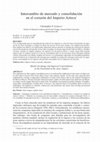Books by Christopher Garraty
Table of Contents, 2018
This timely volume explores the everyday lives of ancient Mesoamerican people from the Formative ... more This timely volume explores the everyday lives of ancient Mesoamerican people from the Formative through the Postclassic. In honor of Dan Healan, who devoted his life’s work to this theme, several notable scholars present novel research to reconstruct how households produced and exchanged goods, carried out private and public rituals, built their residences and neighborhoods, organized their towns and cities, earned a living, observed the stars, and even fomented resistance within powerful states throughout Mesoamerica.

"Ancient market activities are dynamic in the economies of most ancient states, yet they have rec... more "Ancient market activities are dynamic in the economies of most ancient states, yet they have received little research from the archaeological community. Archaeological Approaches to Market Exchange in Ancient Societies is the first book to address the development, change, and organizational complexity of ancient markets from a comparative archaeological perspective.
Drawing from historical documents and archaeological records from Mesoamerica, the U.S. Southwest, East Africa, and the Andes, this volume reveals the complexity of ancient marketplace development and economic behavior both in hierarchical and non-hierarchical societies. Highlighting four principal themes-the defining characteristics of market exchange; the recognition of market exchange archaeologically; the relationship among market, political, and other social institutions; and the conditions in which market systems develop and change-the book contains a strong methodological and theoretical focus on market exchange.
Diverse contributions from noted scholars show the history of market exchange and other activities to be more dynamic than scholars previously appreciated. Archaeological Approaches to Market Exchange in Ancient Societies will be of interest to archaeologists, anthropologists, material-culture theorists, economists, and historians."
Papers by Christopher Garraty

Unlike other regions of the U.S. Southwest, prehistoric southeastern Arizona is not marked by a s... more Unlike other regions of the U.S. Southwest, prehistoric southeastern Arizona is not marked by a single dominant material cultural tradition but, rather, incorporated a heterogeneous mix of material culture traits, including attributes of the Hohokam, Salado, Mogollon, Trincheras, and Chihuahuan traditions (e.g., Fulton and Tuthill 1940; Heckman et al. 2000; Tuthill 1947; Vanderpot and Altschul 2007). Southeastern Arizona is traversed by the San Pedro River, which was used as a transportation artery between the desert and grasslands and facilitated transmission of people, ideas, and material culture. Consequently, questions concerning cultural diversity and social interaction among groups from different cultural backgrounds are crucial for this region (Vanderpot and Altschul 2007). I address the question of multiculturalism and social interaction in southeastern Arizona based on a longitudinal analysis of decorated serving vessels from the Mescal Wash Site (Mescal Wash, for short). B...
Journal of Anthropological Archaeology, 2011
... Barnett, 1995], [Rice, 1996] and [Rice, 1999]). None of these Neolithic processes are unamb... more ... Barnett, 1995], [Rice, 1996] and [Rice, 1999]). None of these Neolithic processes are unambiguously coeval, however. Residential stability in particular has proven to be a poor indicator of pottery use. In a cross-cultural sample of ...

Ancient Mesoamerica, 2013
Instrumental neutron activation analysis (INAA) of Middle and Late Postclassic and Early Colonial... more Instrumental neutron activation analysis (INAA) of Middle and Late Postclassic and Early Colonial period decorated and plain ware ceramic sherds from Brainerd's excavation collections at Cerro Portezuelo highlight diachronic changes in commercial pottery exchange prior to and during the Aztec empire and during the first century of Spanish colonial rule. The INAA results show that before the Aztec empire (Middle Postclassic period; a.d. 1150–1350), most pottery used at Cerro Portezuelo was made locally or imported from various sources in the southern Basin of Mexico. After the empire formed (Late Postclassic period; a.d. 1350–1521), local pottery exchange continued, but Tenochtitlan became the primary source of imported pottery in Cerro Portezuelo, despite its location within Texcoco's domain, which was likely attributable to Tenochtitlan merchants' successful exploitation of lake trafficking. After the Spanish Conquest (Early Colonial period; a.d. 1521–1625), Texcoco bec...

Logan Simpson archaeologists recovered a total of 18,799 ceramic artifacts during testing and dat... more Logan Simpson archaeologists recovered a total of 18,799 ceramic artifacts during testing and data recovery within the FLA Phase 2 and Phase 3 loci. The collection mainly consists of body sherds (92 percent) and rim sherds (8 percent) from pottery vessels, but small numbers of non-vessel ceramic artifacts (e.g., figurines, pipe stems, and raw clays), partially reconstructible vessels (PRV), and a complete vessel (CV) also were recovered. The PRVs generally consist of multiple refitted sherds that comprise at least one-third of a complete vessel; for the purpose of quantifying the ceramic data, the PRVs were counted as single items (rather than as individual sherds) to avoid inflating artifact counts. The overwhelming majority of ceramics (95 percent) were collected from Locus 2; ceramic artifacts from this locus outnumber those from Locus 3 by more than 20 to 1. The project area is situated outside but adjacent to the originally defined northwest site boundary of La Ciudad. However,...

The relationships between market and political institutions have varied in different times and pl... more The relationships between market and political institutions have varied in different times and places, but no market system was (or is) devoid of political involvement. The contrasting approaches of the Aztec empire and Spanish colonial regime to the Basin of Mexico market system are instructive about the ways that commercial agents (producers, traders) respond to 'top- down' pressures from state elites to steer and direct the commercial economy to their political advantage. The results of this study suggest that the market system in the Basin nourished under the Aztec empire but suffered a decline after the Spanish conquest. To establish a window on state-market relationships, I focus on pottery production and exchange (plainware and decorated wares) prior to and during the period of Aztec imperial rule (ca. A.D. 1200-1520) and subsequent colonial period (ca. A.D. 1520-1650) based on compositional analyses and analyses of form specialization and attribute standardization. I...
Oxford Handbooks Online, 2016

Ancient Mesoamerica, Jun 30, 2000
This article explores the complex, multidimensional nature of Aztec social organization and, spec... more This article explores the complex, multidimensional nature of Aztec social organization and, specifically, the concept of “eliteness,” as it applies to the Aztecs. I discuss both why we can speak of Aztec “elites” and how we can monitor them using ceramic data. I argue it is possible to distinguish elites archaeologically by identifying the ceramic attributes and variables that best reflect feasting behavior, one of the primary practices the Aztecs used to socially construct and reproduce unequal relations of power, wealth, and estate. Ceramics thus served as one of the primary media through which politically and socially charged “communication” occurred among the Aztecs. I define and evaluate six ceramic indices of eliteness using Late Aztec ceramic data (ca. a.d. 1350–1520) from Teotihuacan, an Aztec period altepetl (city-state) located in the northeastern Basin of Mexico. I use the most effective eliteness indices to interpret the intrasite spatial patterning of elite residences at Late Aztec Teotihuacan and infer some observations about the social and political organization of the altepetl.

Una vía importante para la consolidación del poder de los imperios es cortar las bases tradiciona... more Una vía importante para la consolidación del poder de los imperios es cortar las bases tradicionales de ingresos de las elites sometidas y redirigir los flujos de recursos de las áreas sujetas a las capitales provinciales. Para cumplir este objetivo, los gobernantes imperiales aztecas pusieron en marcha una estrategia de apropiación de los beneficios del mercado de las elites sometidas al corazón imperial del Valle de México. Estudios recientes, basados en análisis químicos de cerámica sin decoración azteca y vasijas negro sobre-naranja, sugieren que la cerámica hecha en el área de Tenochtitlan entró en los mercados de las entidades políticas vecinas, incluyendo a los aliados acolhuas de Texcoco. Los gobernantes imperiales de Tenochtitlan probablemente invirtieron en el desarrollo del mercado para estimular la producción artesanal comercial y la exportación, acrecentando así los ingresos del gobierno procedentes de los impuestos del mercado. One important way that empires consolidat...

""Ancient market activities are dynamic in the economie... more ""Ancient market activities are dynamic in the economies of most ancient states, yet they have received little research from the archaeological community. Archaeological Approaches to Market Exchange in Ancient Societies is the first book to address the development, change, and organizational complexity of ancient markets from a comparative archaeological perspective. Drawing from historical documents and archaeological records from Mesoamerica, the U.S. Southwest, East Africa, and the Andes, this volume reveals the complexity of ancient marketplace development and economic behavior both in hierarchical and non-hierarchical societies. Highlighting four principal themes-the defining characteristics of market exchange; the recognition of market exchange archaeologically; the relationship among market, political, and other social institutions; and the conditions in which market systems develop and change-the book contains a strong methodological and theoretical focus on market exchange. Diverse contributions from noted scholars show the history of market exchange and other activities to be more dynamic than scholars previously appreciated. Archaeological Approaches to Market Exchange in Ancient Societies will be of interest to archaeologists, anthropologists, material-culture theorists, economists, and historians.""
Latin American Antiquity 15(2):123-143, 2004











Uploads
Books by Christopher Garraty
Drawing from historical documents and archaeological records from Mesoamerica, the U.S. Southwest, East Africa, and the Andes, this volume reveals the complexity of ancient marketplace development and economic behavior both in hierarchical and non-hierarchical societies. Highlighting four principal themes-the defining characteristics of market exchange; the recognition of market exchange archaeologically; the relationship among market, political, and other social institutions; and the conditions in which market systems develop and change-the book contains a strong methodological and theoretical focus on market exchange.
Diverse contributions from noted scholars show the history of market exchange and other activities to be more dynamic than scholars previously appreciated. Archaeological Approaches to Market Exchange in Ancient Societies will be of interest to archaeologists, anthropologists, material-culture theorists, economists, and historians."
Papers by Christopher Garraty
Drawing from historical documents and archaeological records from Mesoamerica, the U.S. Southwest, East Africa, and the Andes, this volume reveals the complexity of ancient marketplace development and economic behavior both in hierarchical and non-hierarchical societies. Highlighting four principal themes-the defining characteristics of market exchange; the recognition of market exchange archaeologically; the relationship among market, political, and other social institutions; and the conditions in which market systems develop and change-the book contains a strong methodological and theoretical focus on market exchange.
Diverse contributions from noted scholars show the history of market exchange and other activities to be more dynamic than scholars previously appreciated. Archaeological Approaches to Market Exchange in Ancient Societies will be of interest to archaeologists, anthropologists, material-culture theorists, economists, and historians."